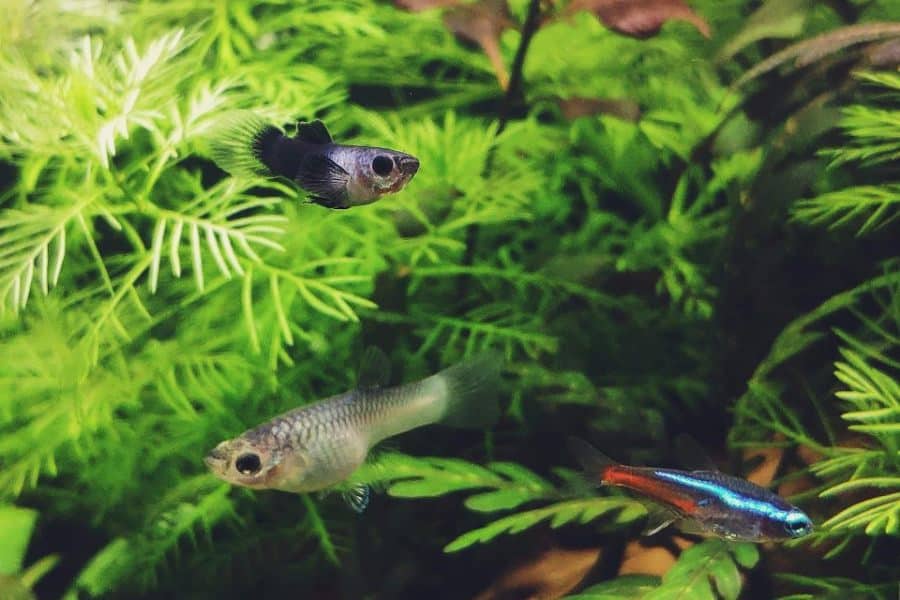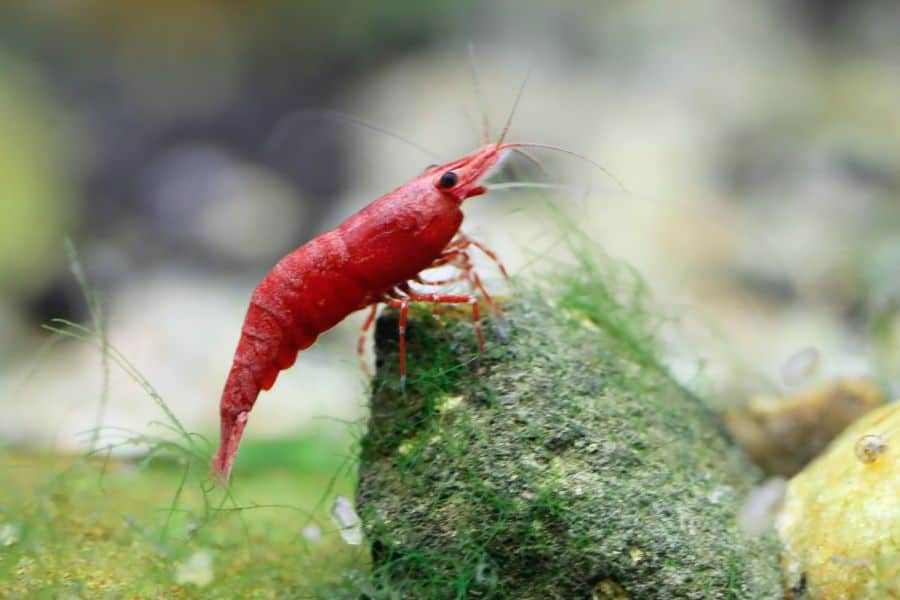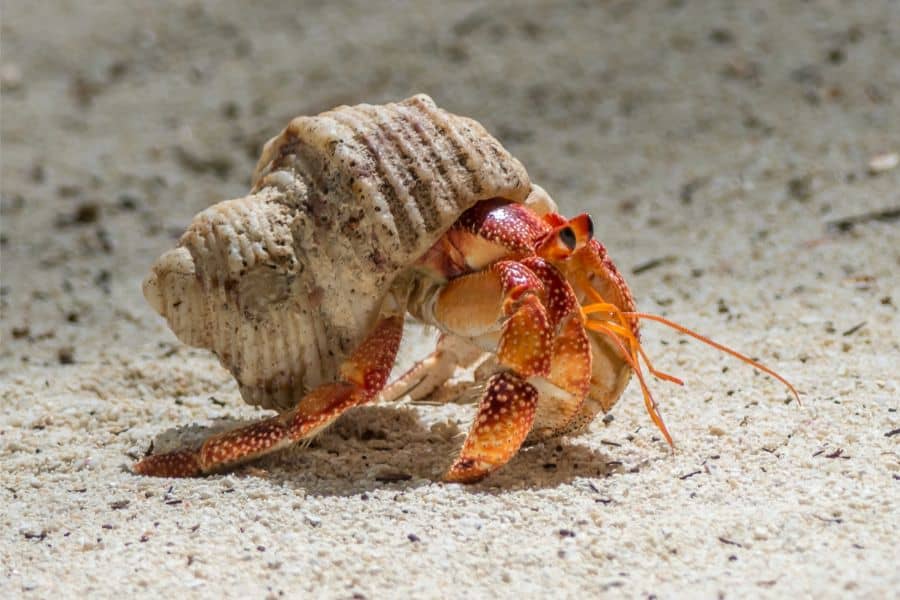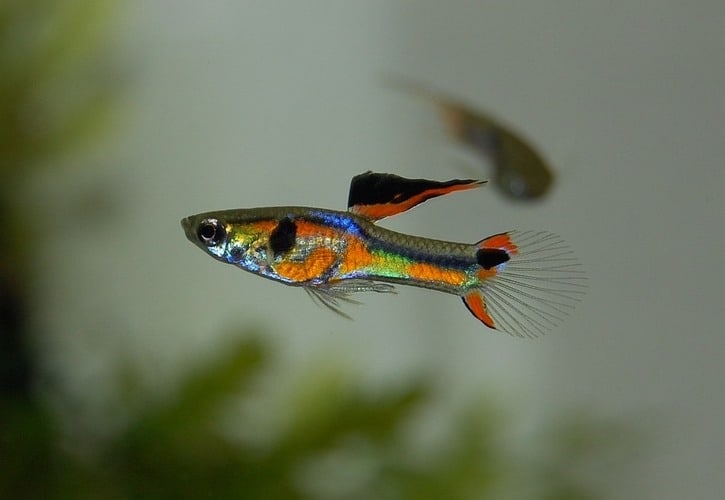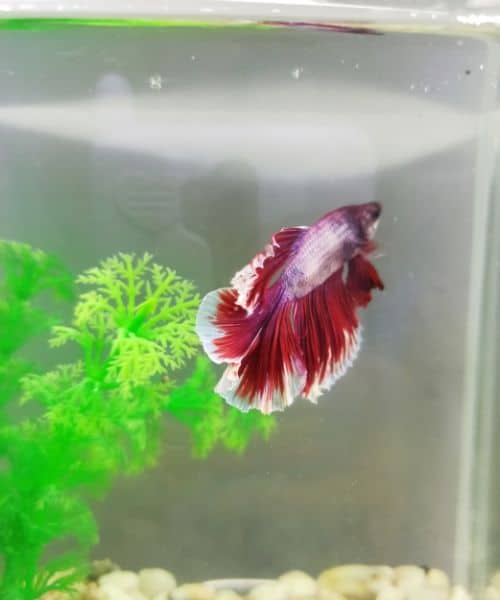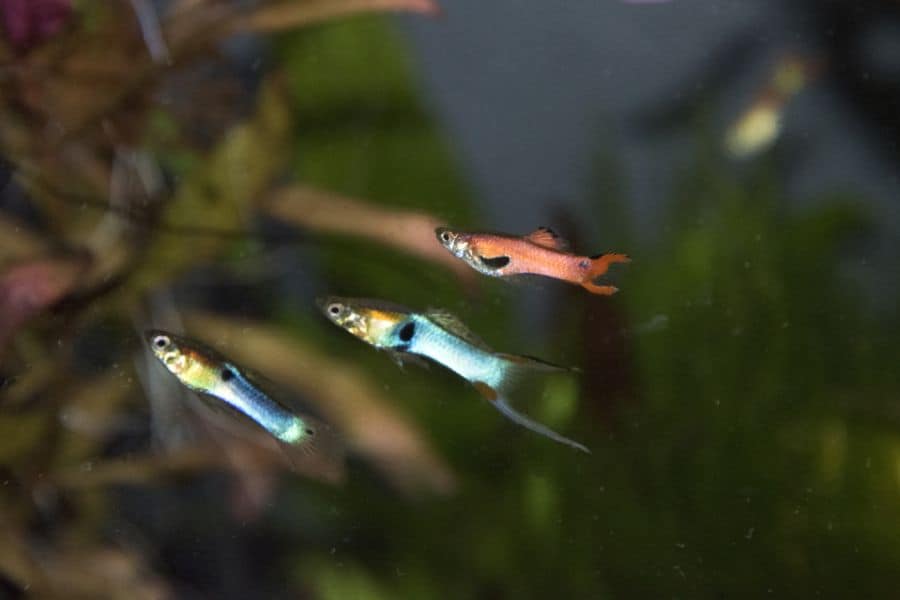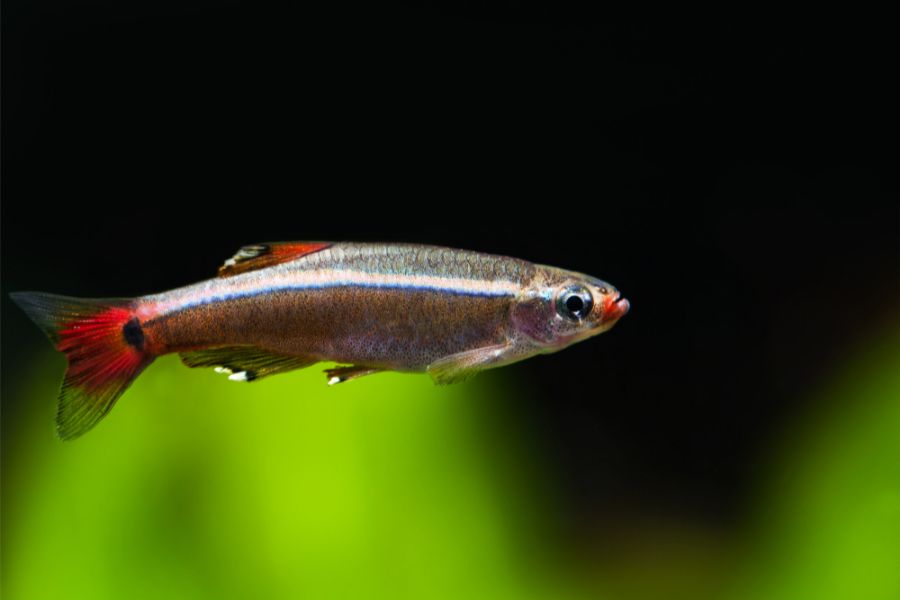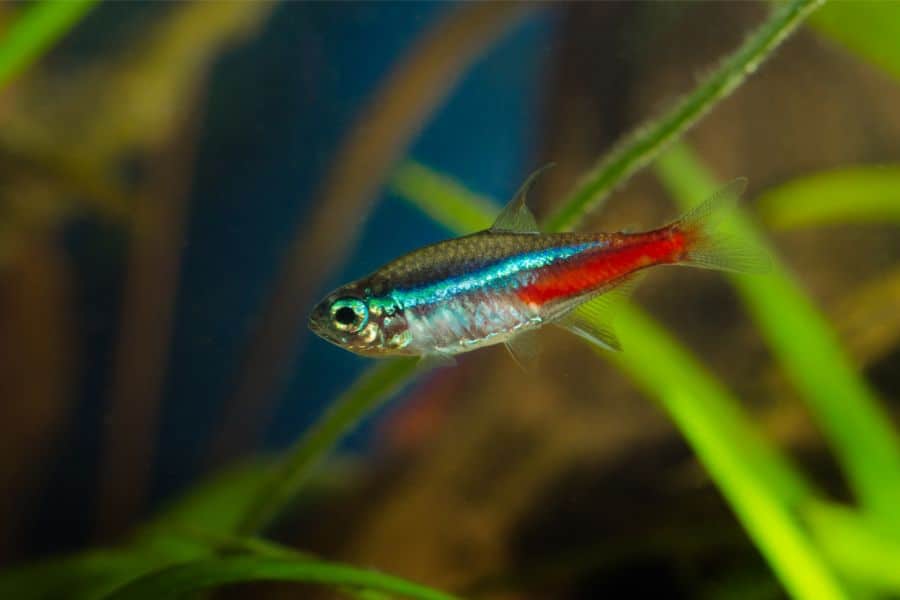Experienced aquarists will tell you there are no fish for one-gallon tanks or fish bowls. Five-gallons tanks are the recommended minimum for even the tiniest single aquarium fish.
This standard is because tanks under five gallons cannot shield the fish from dangerous chemical buildups and fluctuations in water parameters, i.e., pH, temperature, ammonia, etc.
You may choose to keep a small fish in a one-gallon tank, but it will be deprived of its needs, get stressed, and eventually pass away. It may survive for a while, but its existence is torture, even to the smallest species like the tetras, bettas, and guppies.
Simply put, you can, but it is ethically inhumane. Read on to learn of the factors that may give you a reason to put a small fish in a one-gallon tank. Get to know the various types of fish and aquatic pets that can survive in such confined quarters.
Factors to Consider When Using Small Fish Tanks
It is important to understand that even though a one-gallon tank looks cute and charming, it’s considered unethical to keep fish in something so tiny.
According to recent research from leading scientists, fish are sentient creatures capable of experiencing pain and other forms of suffering like stress.
As responsible beings, it is our moral duty to provide humane treatment to fish and refrain from any actions that may cause them harm, agony, or distress.
This obligation holds utmost importance in the fishing industry, fish trade, aquariums, and hobbyists’ sectors. The welfare of fish should be a top priority, and one of prioritizing them is by reducing the suffering of fish in captivity.
The biological reality is that one gallon of water simply can’t sustain the fundamental needs of fish. The environmental conditions in such a tiny space aren’t enough to support a fish’s proper growth and development, which can lead to poor health.
Overall, keeping any fish in one-gallon tanks is unethical, not just because it confines the fish to a very small space, but because it’s ultimately unsustainable and harmful to your beloved pet.
Under special circumstances, many types of small fish can be manageable in one-gallon tanks. Otherwise, it is best to get a bigger aquarium. Let’s take a look at some of the special factors that can lead you to put a fish in a small one-gallon tank:
1. Type of Fish, Size & Age
As aquatic animals, fish have evolved to dwell in bodies of water like seas, deep oceans, lakes, and canals that don’t have boundaries stopping them from traveling freely. Aquariums are foreign to them, but while they can be livable, they are essentially trapped in that small space.
That limitation is made even more drastic by a one-gallon tank.
Plus, many fish are social creatures, often swimming in groups called schools or shoals. You can’t keep that number of fish in a measly one-gallon tank; they won’t be able to swim freely and avoid stress. The result of this is a slow death with a very short lifespan.
Small juvenile fish are great candidates for one-gallon bowls, but they would require bigger tanks when they reach breeding age. Also, the older the fish gets, the bigger it becomes and outgrows the small tank.
Despite the small sizes, you also have to consider certain small types of fish featuring hardy properties and solitary behaviors (so that you can keep them alone instead of a school). Fish that can survive wide temperature ranges are ideal for smaller tanks than those that do not.
Also, consider fish that breathe air, like the sparkling and chocolate gourami, which can live in small spaces by breathing in atmospheric air. Other small-sized fish with hardy properties include the killifish minnow, white cloud minnows, and Medaka rice fish.
2. Length of Stay in The Tank
Small fish that are less than 1.5 inches, like the tetras, can survive in one-gallon tanks, albeit for very short periods.
This is okay if you perform certain maintenance on their bigger tank, treating, quarantining the fish, acclimating, or buying it from the store.
3. Water Parameters & Quality
A small fish can live for ages in a one-gallon tank if you are able to keep the water parameters stable. Keeping water conditions at their ideal ranges for your fish is the hardest part of raising a fish in a small tank.
If you crack the code on this front, then you can raise the small fish for a long time. In fact, any fish can survive in any tank size, provided it fits, and the water parameters are optimal.
However, the problem is that there are no one-gallon tanks feasible with the equipment & environments you would need to make those parameters stable for any type of fish.
All the maintenance procedures you would need to keep the water quality optimal cannot be applied effectively to one-gallon tanks.
This means that parameters are unpredictable and easily fluctuate. Overfeeding can happen quickly, leading to spikes in ammonia and changes in the nitrogen cycle. Life-critical elements, including biofilm and healthy bacteria, are easily destroyed in smaller tanks.
4. Ecosystem & Equipment – e.g., heaters & filters
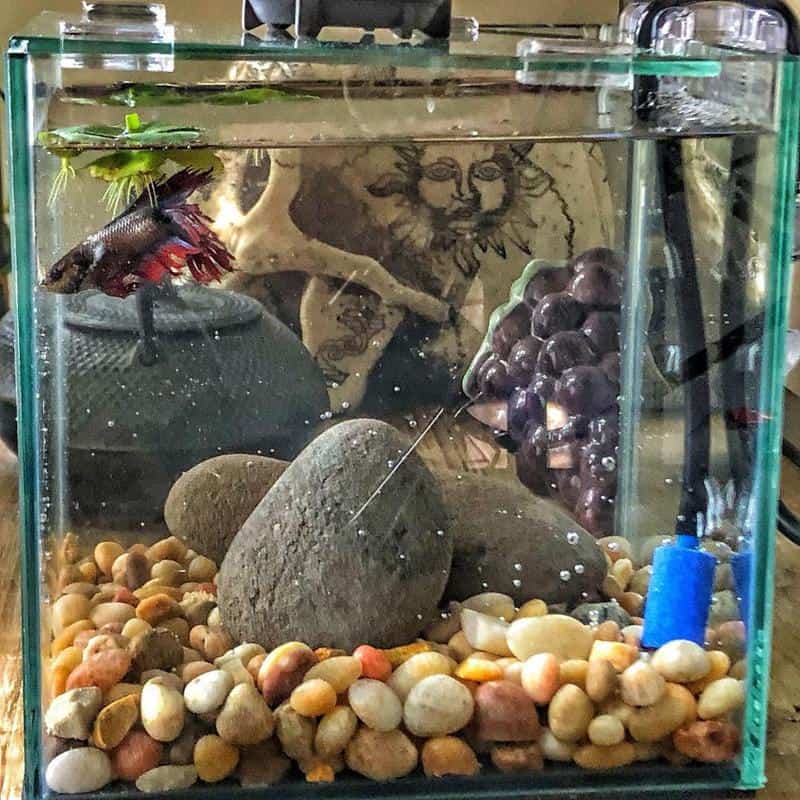
The smaller the body of water, the harder it is to keep the temperature and the ecosystem stable. Such parameters include the temperature, water plants, substrate, and water pumps to create moving water. Temperature is the biggest culprit since it is harder to control.
Temperature control in aquarium setups depends on heaters. Small tanks require the lowest wattage heaters to ensure you do not change the ideal temperatures by a bigger margin than the recommended ones.
This is harder for one-gallon tanks since the lowest-wattage heaters in the market are too powerful to keep the ideal temperature ranges in such a small setup. Also, it is easier to maintain stable conditions in tropical regions where the atmospheric weather is more stable compared to non-tropical regions.
For a one-gallon fish tank, a heater with a wattage of 5-10 watts is generally recommended. The exact wattage needed may vary depending on factors such as the ambient room temperature, the desired water temperature, and the type of fish and plants in the tank.
It is important to choose a heater that is specifically designed for small aquariums and to follow the manufacturer’s instructions for proper installation and operation.
Additionally, you need to regularly monitor the water temperature with a thermometer and adjust the heater as necessary so as to maintain a stable and safe environment for most fish.
Other animals, like snails, don’t have this challenge. Snails are some of the rare creatures that can naturally control parameters in the tank, from water parameter changes to waste reduction and algae growth. This makes snails a much easier species to raise in one-gallon tanks long-term.
5. A Breeder Setup
If you notice an experienced aquarist showcasing a fish in a small tank or bowl on social media, this is probably their setup.
A breeder setup combines a small tank and a larger, bigger tank, both sharing water and an ecosystem.
It is a one-system with two different containers. The two tanks are placed side by side, or the smaller one inside the larger one, all connected with filters, hoses, water pumps, and air pumps.
Water is cycled between the bigger and smaller tank to maintain stable water parameters and eradicate maintenance plus waste problems.
All filtration and oxygenation from the larger tank are circulated to the smaller one-gallon tank, and so forth. Its purpose is to help you breed more fish without having to buy another large tank.
Best Small Fish & Pets For One-Gallon Tanks: Long Term
One-gallon tanks are too small to support most types of fish for a long time.
That doesn’t mean the aquariums are useless. Here are a few interesting aquatic pets you can put in a one-gallon tank for a long time.
1. Shrimps
The shrimp is the Number One recommended aquatic life for one-gallon tanks/bowls. This type of invertebrate only requires a little biomass upkeep, and one gallon is enough to process its waste. It also doesn’t require a lot of swimming space, as they just like to graze and hide among the aquarium decors.
Best of all, shrimps have interesting and beautiful colorations and behavior that is just as delightful to look at as fishes.
A good example is the Neocaridina shrimp, also known as the red cherry shrimp. The species does best in groups of 15 in a tank setup filled with java moss, a heater, and a sponge filter.
That said, you do need to know a couple of things before you decide to raise shrimps. First of all, some species are prone to cannibalism, so it’s best to stick with one type of shrimp and avoid mixing them.
Secondly, 1-gallon tanks are great for small-sized species, such as the cherry shrimp. However, be aware that they can grow larger than 1 inch, so you’ll have to move them to a bigger tank if they outgrow 1 gallon.
The aquarium plants you might choose to house in your aquarium should also be taken into consideration. Any omnivorous shrimp might choose to skip the meal you offer them in place of the greenery, especially if you don’t feed them high-quality food.
2. Hermit Crabs
Hermit crabs are another great substitute for putting fish in a one-gallon tank. They’re very interesting and social animals that enjoy exploring their environment and can even be trained to do tricks.
As a good side benefit, they virtually never require maintenance beyond feeding and cleaning. Just vacuum or remove their waste once a week, at the very least. They have very little pollution potential you can add two or three to a tank.
They are also more animated than snails, and you can even observe interesting behavior, particularly when they attempt to fit themselves into the shells they discovered.
Since hermit crabs like to take up residence in shells they find, you can even add some cute “homes” for them to live on, and they will move into their new houses without fuss.
3. Snails
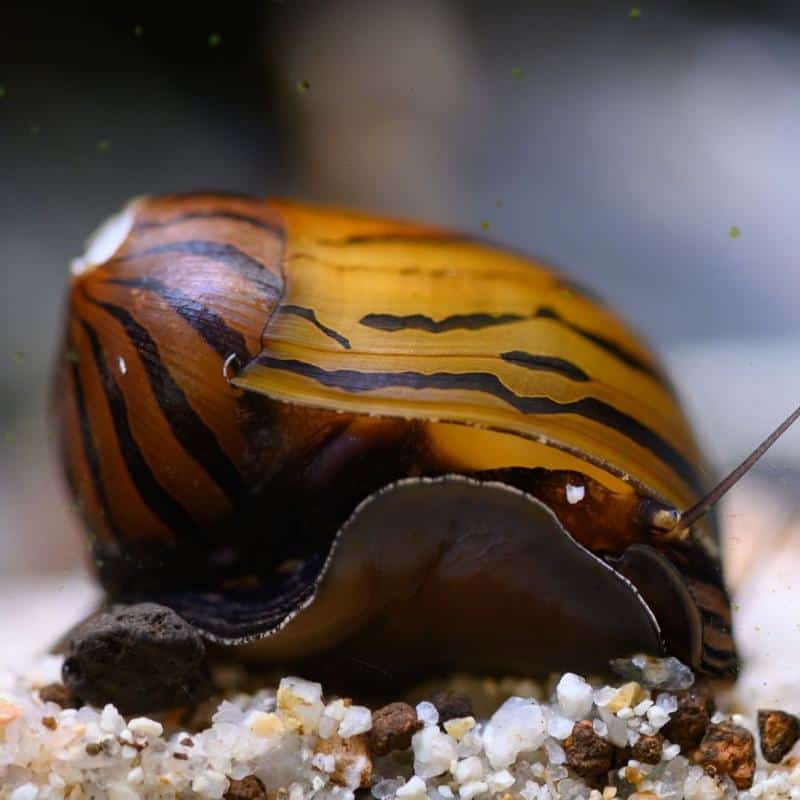
Snails can be a tricky topic when talking about one-gallon tanks, mostly because there’s such a huge variety of them.
While tame, medium-sized snails like nerites or assassin snails can be raised in a tank; other varieties present more complications. Even assassin snails, although perfect in aesthetics and behavior, need other snails to prey upon, so you will need to provide them it a constant supply of prey.
Smaller snails, such as ramshorns, can breed very quickly and overrun your small one-gallon tank, while apple snails might grow too big for such a small environment.
As long as you stick to medium-sized snails that don’t reproduce too much, snails can be an entertaining addition to any compact aquarium.
4. Sea Monkeys
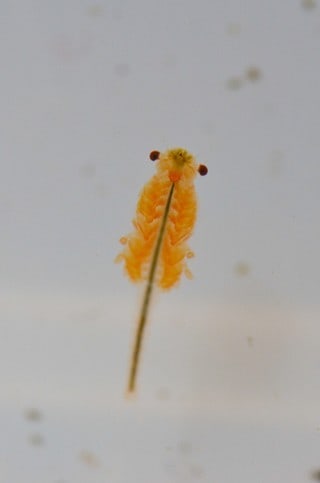
Sea monkeys are a type of brine shrimp that are sold as novelty pets, which can make for a great addition to a one-gallon tank.
They’re named for their monkey-like appearance and the fact that they live in saltwater. Sea monkeys are a type of crustacean, and they are typically sold in a dehydrated state.
When water is added, the sea monkeys will hatch and begin to swim around in the water. They are easy to care for and can provide hours of entertainment, making them a popular choice for children.
If you have other aquariums, you can raise sea monkeys in a one-gallon tank and use them to feed live food to freshwater aquariums. As long as you don’t include seawater when you add sea monkeys to your freshwater aquarium, your fish will feast on the little critters.
Best Small Fish For One-Gallon Fish Tanks: Short Term
5. Guppies
Guppies are a small and hardy species that rarely grow past 2 inches. They can tolerate a vast range of water parameters and this makes them ideal for temporarily habiting a 1-gallon tank.
The small tank situation is not ideal for longer stays of more than a few days. Only put the guppies in the one-gallon tank if you are planning on putting them in a bigger tank later on.
Guppies are active swimmers, so they need a lot of space. Plus, since they’re schooling fish (2 -3 groups of guppies in one gallon), they prefer the company of many other guppies, or else they will feel stressed and get sick.
Guppies are also heavy polluters that emit waste all the time, requiring a strong filtration system that you can’t reliably install in a small tank.
This means a breeding setup connecting the one-gallon tank to a much bigger one is needed to ensure the water quality stays optimal. You cannot have guppies in a separate one-gallon tank for long – it lacks a well-connected filtrations system.
6. Bettas
Is a 1-gallon aquarium good enough to maintain a betta? This is one of the most common questions regarding small tanks since most of the buyers want to keep a betta fish.
Bettas are among the most popular and most adaptable freshwater fish. They are also hardy in nature and typically need minimal maintenance. Any buyer can easily take care of a Betta fish, regardless of experience.
Apart from being hardy, bettas are also labyrinth fish, meaning they can breathe air directly from the surface. This makes them better candidates for one-gallon tanks than guppies, although still inhumane.
Bettas are also naturally curious fishes. They like to swim around and explore their surroundings, and they can grow stressed and withdrawn when not given the proper stimuli. Survival does not equal a good life.
A betta fish in a 1-gallon tank is basically trapped in its tiny enclosure which eventually leads to stress, sickness, weakness, and then death.
Growing to no larger than 3 inches, betta fish make great candidates for small fish that can survive even in small cups.
Despite their size, its scientifically recommended to keep the fish in 2-gallon tanks minimum to achieve their average lifespan of 2 – 5 years.
Related: Best Betta Fish Tank Size
7. Endlers Livebearers
Endlers Livebearers resemble guppies in many ways and are also found in 1-gallon setups.
These small species are quite strong and appealing to look at. They only reach about 1.2 inches in length, which is ideal for those people having small home tanks or inexperienced fish keepers.
You can easily house Endlers together without facing any territorial issues. They’re also hardy and resilient and generally don’t require a lot of special diets.
However, keeping them in a one-gallon tank can be catastrophic long-term, especially if you’re keeping fish of opposite sexes.
This is because Endlers Livebearers are very promiscuous breeders that can give rise to dozens or hundreds of frys, which can easily collapse your tiny ecosystem. This is not an issue in the short term.
8. White Cloud Mountain Minnows
White Cloud Minnows(Tanichthys albonubes) are regarded as some of the best starter fish for new hobbyists, mainly due to their durability and size.
Compared to other small schooling species, they’re quite peaceful and don’t bother other fish in the tank. They also don’t need a demanding diet, as they can feed on anything.
But even though they can survive in 1-gallon tanks, they won’t be very happy with it in the long term. One gallon simply isn’t enough to handle the bio load for this kind of fish, which is why it’s best to only put the fish in small tanks in a breeder setup.
This will reduce large variations in water quality parameters, making your pets less vulnerable to disease and stress.
9. Neon Tetras
Neon Tetras are a tiny freshwater species native to South America. They grow up to an inch long and don’t need extensive care.
Like guppies, they fare well in schools (3 -4) and are known to be hardy. They’re also peaceful and hardly ever engage in conflicts regarding territory or bullying with their kind or other species.
Due to this, they’re a staple offering in any pet shop that sells aquatic animals. Most recommend them to beginner fish keepers since they don’t need any specific care to maintain.
But while neon tetras may be small and easy to care for, this doesn’t mean that they’ll thrive in a one-gallon aquarium long term.
Neon tetras could use a one-gallon tank when breeding. The fry seldom survives in community tanks since parents end up feeding on them. A small tank in a breeder setup helps keep the babies alive while still acclimating them to the same environment as their parents.
Conclusion
One-gallon tanks are not recommended for newbies since it takes tremendous experience and care to ensure the tank doesn’t hinder the life of your fish, regardless of how long the fish spends in the tank.
Also, while some fishes might look like they can live in a one-gallon tank, fishes require an appropriate amount of water to truly thrive. One gallon isn’t enough to provide them with the space and the processing capability that they require to process their waste, especially if they are heavy polluters like goldfish.
Consider other aquatic life apart from fish for your one-gallon tank. Great substitutes include shrimps, hermit crabs, snails, and even sea monkeys – they don’t have as many water requirements and can be just as interesting to watch as fish!
